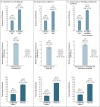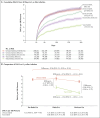Postacute Sequelae of SARS-CoV-2 Infection in the Pre-Delta, Delta, and Omicron Eras
- PMID: 39018527
- PMCID: PMC11687648
- DOI: 10.1056/NEJMoa2403211
Postacute Sequelae of SARS-CoV-2 Infection in the Pre-Delta, Delta, and Omicron Eras
Abstract
Background: Postacute sequelae of severe acute respiratory syndrome coronavirus 2 (SARS-CoV-2) infection (PASC) can affect many organ systems. However, temporal changes during the coronavirus disease 2019 (Covid-19) pandemic, including the evolution of SARS-CoV-2, may have affected the risk and burden of PASC. Whether the risk and burden of PASC have changed over the course of the pandemic is unclear.
Methods: We used health records of the Department of Veterans Affairs to build a study population of 441,583 veterans with SARS-CoV-2 infection between March 1, 2020, and January 31, 2022, and 4,748,504 noninfected contemporaneous controls. We estimated the cumulative incidence of PASC at 1 year after SARS-CoV-2 infection during the pre-delta, delta, and omicron eras of the Covid-19 pandemic.
Results: Among unvaccinated persons infected with SARS-CoV-2, the cumulative incidence of PASC during the first year after infection was 10.42 events per 100 persons (95% confidence interval [CI], 10.22 to 10.64) in the pre-delta era, 9.51 events per 100 persons (95% CI, 9.26 to 9.75) in the delta era, and 7.76 events per 100 persons (95% CI, 7.57 to 7.98) in the omicron era (difference between the omicron and pre-delta eras, -2.66 events per 100 persons [95% CI, -2.93 to -2.36]; difference between the omicron and delta eras, -1.75 events per 100 persons [95% CI, -2.08 to -1.42]). Among vaccinated persons, the cumulative incidence of PASC at 1 year was 5.34 events per 100 persons (95% CI, 5.10 to 5.58) during the delta era and 3.50 events per 100 persons (95% CI, 3.31 to 3.71) during the omicron era (difference between the omicron and delta eras, -1.83 events per 100 persons; 95% CI, -2.14 to -1.52). Vaccinated persons had a lower cumulative incidence of PASC at 1 year than unvaccinated persons (difference during the delta era, -4.18 events per 100 persons [95% CI, -4.47 to -3.88]; difference during the omicron era, -4.26 events per 100 persons [95% CI, -4.49 to -4.05]). Decomposition analyses showed 5.23 (95% CI, 4.97 to 5.47) fewer PASC events per 100 persons at 1 year during the omicron era than during the pre-delta and delta eras combined; 28.11% of the decrease (95% CI, 25.57 to 30.50) was attributable to era-related effects (changes in the virus and other temporal effects), and 71.89% (95% CI, 69.50 to 74.43) was attributable to vaccines.
Conclusions: The cumulative incidence of PASC during the first year after SARS-CoV-2 infection decreased over the course of the pandemic, but the risk of PASC remained substantial even among vaccinated persons who had SARS-CoV-2 infection in the omicron era. (Supported by the Department of Veterans Affairs.).
Copyright © 2024 Massachusetts Medical Society.
Figures




Comment in
-
Postacute Sequelae of SARS-CoV-2 Infection in Several Eras.N Engl J Med. 2024 Oct 31;391(17):1658-1659. doi: 10.1056/NEJMc2411213. N Engl J Med. 2024. PMID: 39476349 No abstract available.
-
Postacute Sequelae of SARS-CoV-2 Infection in Several Eras.N Engl J Med. 2024 Oct 31;391(17):1659. doi: 10.1056/NEJMc2411213. N Engl J Med. 2024. PMID: 39476350 No abstract available.
-
Postacute Sequelae of SARS-CoV-2 Infection in Several Eras. Reply.N Engl J Med. 2024 Oct 31;391(17):1659-1660. doi: 10.1056/NEJMc2411213. N Engl J Med. 2024. PMID: 39476351 No abstract available.
References
Publication types
MeSH terms
Substances
Supplementary concepts
Grants and funding
LinkOut - more resources
Full Text Sources
Medical
Miscellaneous
